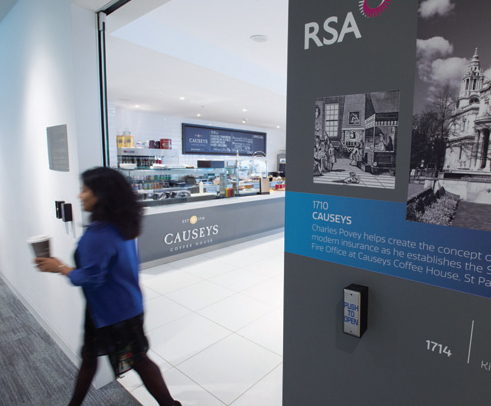Social media has wide uses for employee benefits, but employers are just starting to realise its value as an engagement and communication channel. But there are several top tips to consider for harnessing its power.

If you read nothing else, read this…
- Employers can use internal social networks to send out benefits communications.
- Communications need a clear strategy and purpose to be successful.
- Involving employees in the communications can help increase engagement with benefits.
1. Use internal networks
There are a range of enterprise social networks (ESNs) being used internally within businesses, such as Yammer, Slack and Jive. Facebook At Work is also currently being trialled. These allow employers and staff to build networks and groups, as well as make and comment on posts in a work context.
Organisations are less likely to use public-facing channels, such as Facebook or Twitter, to communicate with staff. These are generally reserved for consumer communications. Andrew Drake, head of flexible benefits at JLT Employee Benefits, says: “I am yet to see [any employer] put anything about their employee benefits on Twitter or Facebook. The fear is when [employers] put something on [external] social media, [they] are opening themselves up to the eyes of the world.”
But there are still uses for these external channels. Capita Employee Benefits is exploring a Twitter, Facebook and YouTube campaign to drive awareness of teacher pensions , for example.
2. Decide on a clear purpose behind communications
Social media will not necessarily work well for all types of benefits or messages that employers want to distribute, so it is important that they create a clear strategy and purpose behind their communications.
Lesley Alexander, managing director at communications consultancy Ferrier Pearce, has seen some hesitancy towards social media, particularly among pension trustees. “It is partly about resourcing and having enough people to respond to comments,” she says.
However, she encourages reward and benefits professionals to see the potential. “It could work well when benefits are changing, [employers] are introducing new benefits, the flexible benefits window is open, [and so on]. It gives immediacy and is another way of getting messages out.”
Getting employees involved with the communications strategy can help with its success. Chris Copland, director at Better Working, says that social media could be used to drive benefits engagement. “[Employers] can get [staff] to share photos or film of themselves experiencing [an employee benefit] to bring it to life or they could have a poll around benefits.”
3. Be prepared to receive feedback
Employers should also ensure that any benefits available are good quality, says JLT’s Drake. “[Employers] need to put an even greater focus on the quality of the benefits because people could voice their dissatisfaction using social media,” he explains. “Word of mouth is bad enough, but when someone has the audience of Twitter that is magnified. Even on an internal network, [employees] have been given a bigger audience than they had just whinging to the person next to them.”
Louise Harris, head of client communications at Capita Employee Benefits, adds that doing due diligence and thinking about this scenario is vital. “What [employers] are creating is a two-way communication and it is really important to listen to what employees say, even if it is negative,” she says.
4. Future benefits communication
Social media could also impact benefits communication in the future, says Jonny Gifford, research adviser at the Chartered Institute of Personnel and Development (CIPD). “One of the big potentials for social media and HR is to profile people. So a single 20-year-old might get a banner come up about cinema vouchers rather than childcare vouchers,” he explains. ”The thing that is holding that back is not the technology; it is whether it is too much of a big-brother thing. It is not clear yet how acceptable that is in an employee/employer relationship.”
Besides ESNs and external-facing social media, there are also reward and recognition apps with a social media element within them, such as being able to give a colleague a virtual pat on the back for other users to see.
“Something like that might be a good way to test social media,” says JLT’s Drake. ”It might get people used to the idea of sharing among the population.”
Now could be the time for employers to look into using ESNs or such apps for their reward and benefits function. “If [employers] are not exploring all channels, then [they] might not be getting the benefit from the benefits,” says Ferrier Pearce’s Alexander. “We have four generations in the workplace now and [they] could potentially exclude a proportion of the workforce.”
Above all, employers should keep relevant in order to increase employee engagement with benefits. “Don’t be scared of social media; embrace it and take it one step at a time,” says Capita’s Harris. “Don’t ignore it because it won’t go away, but it can be a very cost-effective way of opening up a communication channel.”
Case study: RSA Group engages staff with social media network

Multinational insurance firm RSA Group has used Yammer since February 2012. Around 10,000 of its 19,000 global employees are users, and approximately 5,000 of these are engaged, making posts or commenting on posts daily.
Jenny Burns, director of internal communications, brand and social media at RSA Group, says: “From a communications perspective, Yammer has completely turned everything on its head.”
The business has used Yammer around employee benefits in three ways. First, when it decided to make changes to its flexible benefits package, a closed group of employees came together using Yammer to discuss the offering. Then it went out via the network to ask employees to vote for benefits they wanted in the scheme. “We added things such as a Gourmet Society discount card because people said they were interested in getting more discounts,” explains Burns.
Lastly, it used Yammer to communicate the changes once the new package launched.
Rather than posting messages from the HR or reward department, RSA has around 500 ‘Trail Blazers’: individuals it uses to communicate with the Yammer population who have built a good following. “We used people in the network to communicate what their favourite elements of the proposition were,” explains Burns. “It isn’t a corporate channel. It is a channel for the people so we try to avoid anything that looks slick and official.”
Yammer also allows the organisation to target communications. “In the last [flexible benefits] sign-up period, we gave employees the opportunity to buy a discounted bicycle so we tapped into a Yammer group about cycling to work,” says Burns. ”[We] can target specific communities rather than doing big blanket communications, which we would have done in the past.”
Viewpoint: Employers and staff need to be aware of resonsible use of social media

For many businesses social media is now a key tool in internal communications, particularly for those with a remote or global workforce. Social media platforms transform traditional employee relations in a cost effective way, building a sense of community, culture and connection. This can be an ideal forum to disseminate updates and announcements relating to benefits schemes.
More often than not, the influence of social media on a business has already been felt before consideration of all the risks it may pose. Anything published on social media has the potential for immediate and pervasive disruption and reputational damage. It can be very difficult to delete or contain something once posted and, by its nature, it will usually be disclosable in legal proceedings.
Any employee using social media should be made aware of their obligations regarding confidentiality and data protection and the need to carefully consider the tone and content of posts to avoid any breaches of discrimination law. A prudent employer will prepare a suitable policy to address the risks posed by social media use in the workplace and inform employees that all use of social media is subject to that policy. Employers in regulated sectors will have additional pressures to consider.
When drafting a social media policy, an employer should carefully consider the balance it wishes to strike between placing a reasonable level of trust in the employee and setting clear guidelines on responsible use. Clearly defining what constitutes misuse of social media and the implications will help if things go wrong – case law has shown that equivocal policies can undermine the reasonableness of an employer’s position.
Lastly, if using social media to communicate details of benefits schemes, consider the pace of cultural change and stay ahead of the challenges presented as social media is embedded further into working life.
Chris Tutton is partner and head of the London employment team at Irwin Mitchell